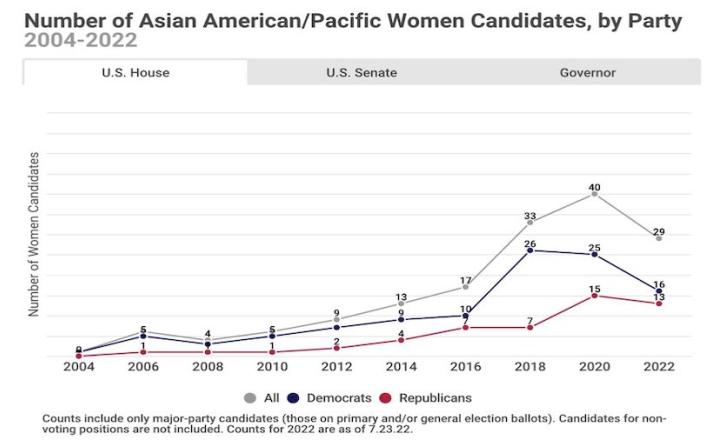US: Data on 2022 women candidates by race and ethnicity
Source: CAWP
The 2022 midterms have led to some new records for women candidates for the U.S. House, U.S. Senate, and governor in various race and ethnicity groups, according to an analysis of candidate filings from CAWP. Asian American/Pacific Islander, Black, Latina/Hispanic, and white women have all set new candidacy records this year, though not at all levels of office.
CAWP began collecting data on candidate race in 2004 using a system of self-identification for candidate race and ethnicity determination. Because this data relies primarily on candidate response to CAWP’s self-ID query and our queries occasionally go unanswered, there remain a small number of candidates for whom we were unable to determine racial identification. This is alluded to when we say “at least” preceding a reported figure below. Additionally, because candidates may, for various reasons, exit political races and no longer appear on ballots, these numbers can change slightly moving forward.
Beginning this year, CAWP no longer reports an aggregate number of “women of color” in our data collections on candidates and officeholders and instead provides disaggregated data for all women by race and ethnicity. This change was guided by our desire to move away from treatment of women as monolithic and challenge the centering of whiteness as a default racial/ethnic category. Of particular note here, because multiracial women are included in counts for each group with which they identify, adding the numbers below will not yield the total number of women of color running for various offices in this year’s midterms.
Click here to access the data.

The 2022 midterms have led to some new records for women candidates for the U.S. House, U.S. Senate, and governor in various race and ethnicity groups, according to an analysis of candidate filings from CAWP. Asian American/Pacific Islander, Black, Latina/Hispanic, and white women have all set new candidacy records this year, though not at all levels of office.
CAWP began collecting data on candidate race in 2004 using a system of self-identification for candidate race and ethnicity determination. Because this data relies primarily on candidate response to CAWP’s self-ID query and our queries occasionally go unanswered, there remain a small number of candidates for whom we were unable to determine racial identification. This is alluded to when we say “at least” preceding a reported figure below. Additionally, because candidates may, for various reasons, exit political races and no longer appear on ballots, these numbers can change slightly moving forward.
Beginning this year, CAWP no longer reports an aggregate number of “women of color” in our data collections on candidates and officeholders and instead provides disaggregated data for all women by race and ethnicity. This change was guided by our desire to move away from treatment of women as monolithic and challenge the centering of whiteness as a default racial/ethnic category. Of particular note here, because multiracial women are included in counts for each group with which they identify, adding the numbers below will not yield the total number of women of color running for various offices in this year’s midterms.
Click here to access the data.